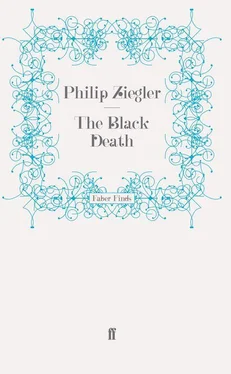However reluctant some of the priests may have been to expose themselves, the clergy of Somerset, another county in the Bishop’s diocese, did in fact suffer greatly as a result of the Black Death. {240} Institutions to new benefices rose from a more or less normal figure of nine in November 1348 to thirty-two in December, forty-seven in January 1349, forty-three in February, thirty-six in March, forty in April and then fell away to twenty-one in May and a mere seven in June – the month in which the Bishop thought fit to set forth on his travels again. So extreme was the confusion that the Bishop felt it necessary to insert a saving clause in all his appointments protecting his position in case, in a moment of excusable aberration, he instituted a priest to a benefice which in fact was not vacant at all. It would be most unwise to generalize on the basis of a single county but it is fair to say that the evidence of Somerset shows no tendency on the part of the parish priests to shirk their terrifyingly perilous responsibilities.
Such data needs closer analysis before they can provide more than an indication of a general trend and often the material for such an analysis does not exist. Though Gasquet himself does not mention the fact it seems, for instance, that in the case of Somerset about a quarter of the new institutions were the result of the resignation of the previous incumbent rather than his death. But, in its turn, for this figure to mean much one would have to know what inspired the individual resignation. Was it reluctance to face the dangers which confronted a parish priest during a lethal epidemic, the economic impossibility of soldiering on in an anyway poor parish which had now lost the majority of its more prosperous parishioners or, perhaps most probable, the translation of the incumbent to another, more important parish which had lost its priest? Even among those who died the statistics are not wholly conclusive since one or two at least may have been the victims of old age, accident or other disease rather than the Black Death. Such facts will never be established: the historian is lucky even if he finds proof that the vacancy was caused by death, let alone information about its cause.
Professor Hamilton Thompson has pointed out other considerations which throw doubt on statistics of this kind. For one thing, the place of death is rarely specified. If a Yorkshire parish priest died of the Black Death while on duty in Canterbury or a priest from a rural Hampshire parish preferred to tend his flock from his comfortable house in Winchester, then it would be misleading to quote his death as evidence of the mortality in his proper county or his proper deanery. Another flaw is that a few institutions were not recorded in the Register, presumably because of the muddle and stress caused by the hurried appointment of a quite abnormal number of new priests at a time when the officials responsible were themselves leaving their posts vacant with alarming speed. For certain important areas, too, the records are not available. And finally, it has proved virtually impossible to establish a list of benefices which can categorically be stated to be complete. {241} Calculations made on such a basis still possess great value, but almost always they must be used with caution and a certain scepticism.
A fortiori this is true when figures for the mortality among the clergy are extended to cover laics as well. It would be extremely rash to accept unquestioned Cardinal Gasquet’s firm assertion: ‘It cannot but be believed that the people generally suffered as greatly as the clergy, and that, proportionally, as many of them fell victims to the scourge.’ {242} It can be contested that the beneficed clergy, with their education, high standard of living and less cramped living conditions, were much better placed to survive than their unfortunate flocks. But, on the whole, the arguments which suggest a higher death rate among priests than laics are more convincing. For one thing there was the nature of their work which, if conscientiously carried out, brought them into constant contact with the infected. In particular in the areas where the pulmonary form of the disease was rife, this must have been close to a sentence of death on any priest resolved to do his duty. For another, as Professor Russell has pointed out, the fact that the average age of the clergy was higher than that of the population as a whole meant that, in any given year, a higher proportion of priests were likely to die. {243} And finally, though the smaller size of the priestly household reduced the chances of infection, it seems also to have been the case that, once such a household was infected, the chances of any survivals were proportionately less. One rat family to a houshold and three fleas to a rat seems to have been the norm; the greater the number of infected fleas in proportion to potential human victims, the smaller the chances of escape.
No final answer to this conundrum will ever be forthcoming. But it would be reasonable to state as a general rule that the proportion of beneficed clergy who died in any given diocese could not possibly have been much smaller than the corresponding figure for the laity and is unlikely to have been very much bigger. Arbitrary limits of 10 per cent less and 25 per cent more seem to provide a reasonable bracket within which the correct figure must be encompassed.
Dr Lunn has calculated that 47.6 per cent of the beneficed clergy in the diocese of the Bishop of Bath and Wells died of the Black Death. It can therefore be said, with reasonable confidence, that it is unlikely that more than 52 per cent or less than 35 per cent of the total population met a similar fate. A safer, because looser way of expressing the same proposition would be to say that, taking a conservative view, between a third and half the people must have died.
The figures for the mortality among beneficed clergy can be used with much greater confidence when it comes to establishing a ratio between different areas. If twice as many clergy died in Yorkshire as in Northamptonshire, then it is reasonable to assume that more or less twice as many laymen died as well. It would be tempting to apply the same mathematics to cities and towns as well as larger areas, but, obviously, the narrower the statistical base, the more risk there is of serious distortions being introduced. It is permissible to compare dioceses on this basis, possibly even archdeaconries, but where deaneries or smaller units are concerned then the comparative figures are no more than a valuable but uncertain pointer towards the relative sufferings of the areas.
* * *
In December 1349, when things were almost back to normal, Bishop Ralph ventured as far as Yeovil. As part of his visitation he held a special service of thanksgiving. To his dismay certain ‘sons of perdition’ armed with ‘bows, arrows, iron bars and other kinds of arms’ attacked the church, injured many of his attendants and kept the Bishop and his congregation bottled up until nightfall. The siege was then transferred to the rectory where it lasted till the following day. At this point the sons of perdition either got bored and went home or, as the official story had it, a party of ‘devout sons of the church’ came to the rescue. {244} Sixty of those concerned were later ordered to do public penance.
It is tempting to read a perhaps impermissible amount into this story. It showed, after all, extreme audacity on the part of the inhabitants of Yeovil to attack a magnate as powerful, both spiritually and temporally, as the Bishop of Bath and Wells. Though the mild revenge which he exacted suggests that the assault was not particularly serious, there must still have been good reason, in the minds of the rioters at least, to indulge in such an escapade. Some particular grievance may have inspired it but the action of the crowd may surely reflect considerable anger against the Bishop and all the ruling classes, a by-product of the intense fear and misery in which they had lived for the previous twelve months. Pressures of that kind must generate intense emotions and such emotions require an outlet.
Читать дальше












